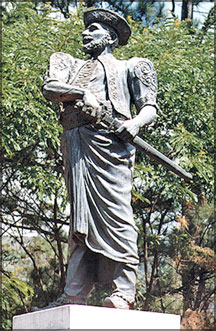Uva uprising and human rights
Janaka Perera
Wednesday, November 26 marks the 190th anniversary of the execution
at Bogambara, Kandy of the patriot and national hero Monarawila
Keppettipola, who led the first anti-British independence struggle
(1817-18) in the Uva Province. It is a fitting occasion to examine the
track record of the ancestors of some of today’s international ‘human
rights’ champions and democracy advocates.
A most amazing aspect relating to the Uva uprising is that until the
Mahinda Rajapaksa Government came to power no attempt was made by anyone
to revoke the gazette notification the British Colonial regime issued on
January 1, 1818 after Keppettipola Dissawe (Provincial Chief) of Uva and
other Kandyan Chieftains turned against the English rulers and joined
the freedom struggle that had commenced the previous year.
For 57 years after independence the Uva heroes remained officially on
the traitors’ list. Their descendants too were helpless in officially
dealing with this grave injustice until the present regime revoked the
notification two years ago. Under this notification, which is in the
National Archives, the Colonial Government confiscated all the assets of
these of the rebel chieftains.
|

Statue of Monerawila Keppettipola, one of the leading
figures of the 1818 rebellion against British rule in Uva
Province. |
When the rebellion spread through Wellassa, Bintenne, Ulapane,
Hewaheta, Kotamale and Dumbara, Sinhala peasants were subjected to
horrible deaths- by execution, hunger and disease. The British laid
waste to the entire area of Wellassa (meaning a hundred thousand paddy
lands). Many a Sinhala noble and Bhikku linked to the rebellion were
beheaded to terrorise the population.
No Sri Lankan Government will be able to totally undo the damage that
the British did to the Uva Province socially, economically and
culturally in the course of brutally crushing the uprising. The
repercussions of this genocidal scorched earth policy are felt to this
day in the Uva region, where entire villages were wiped out and crops
and livestock destroyed.
The soldiers went on the rampage after the Colonial Government
declared Martial Law to combat the freedom fighters facing vastly
superior odds.
They fought more in spirit than in might. Most of them were
slaughtered, their barns plundered, their homes burnt and their lands
confiscated. Many women and children died in ruthless retaliation. The
London Times of October 7, 1818, reported:
“The plan of destroying all the grain and fruit trees in the
neighbourhood of Badulla seems to have been completely carried into
effect, a dreadful measure.”
Generations of poverty-stricken peasants of Wellassa have been paying
the price of the havoc wrought by British troops. Nearly 50,000 Sinhala
villagers have been suffering from malaria - a direct result of the
British destroying thousands of acres paddy land, irrigation works, many
reservoirs and waterways to starve the population to death. The water
that spilled into the surrounding areas turned Wellassa into a large
mosquito breeding ground.
Gradually the jungle claimed the once-flourishing Wellassa, following
over a century of neglect. The devastation was such that it was
virtually impossible to restore the place to what it was before.
Justice Lawrie, Senior Puisne Judge in Colonial Ceylon wrote:
“The story of the English rule in the Kandyan country during 1817 and
1818 cannot be related without shame. In 1819 hardly a member of the
leading families, the heads of the people remained alive; those whom the
sword and the gun had spared, cholera and small pox and privation had
slain by the hundred.” (Revolt in the Temple)
Keppettipola was arrested at Nuwara Kalaviya, Anuradhapura in October
1818.
Following his arrest and that of his lieutenant Madugalle, both were
tried by a Court Martial on November 13 and sentenced to death on
November 26, 1818. Both of them were beheaded.
Altogether the death penalty was imposed on 29 rebel leaders while 27
others including, Pilimathalawe and Ihagama were banished from the
country.
Ihagama, once a Bhikku, was the guiding force behind the uprising
that Keppettipola led.
The then British Deputy Inspector General of Hospitals in Sri Lanka,
Henry Marshall was sympathetic to Keppettipola and visited him in prison
on several occasions. To Marshal (a Scotsman) Keppettipola was like the
Scottish Freedom Fighter, Sir William Wallace whom the English executed
in 1306 for ‘treason’ after he rose against King Edward I.
Marshall was so impressed by the Kandyan Chief’s bravery and
intellect that he took possession of the hero’s skull and presented it
to the Phrenological Society of Edinburgh. Returned to Sri Lanka in
1955, the skull now rests in a monument in the Kandy esplanade.
A very fair British historian, Marshall believed that “had the
insurrection been successful he would have been honoured and
characterised as a patriot instead of being stigmatised and punished as
a traitor.”
To this day, tiny villages are found in the Uva Province - up in the
mountains and deep down in the valleys.
In these huts scattered in the most inaccessible areas live the
descendants of the few survivors who escaped the wrath of the British
troops and hid in remote hamlets.
There were no international human rights organisations in that era to
condemn British barbarism in Uva whereas today they are the very people
- among others - who periodically pontificate on Sri Lanka’s human
rights issues.
After the Uva uprising was crushed the British Colonial Government
embarked on a policy of appropriating on one pretext or another millions
of acres of land belonging to peasants in the Kandyan provinces and sold
them to British capitalists at the nominal rice of one shilling per
acre.
There is no record of the number of peasants rendered landless and
homeless by this inhuman act perpetrated between 1833 and 1886.
The failure of the 1818 freedom struggle was the beginning of the end
of Sri Lanka’s dignity as a nation. Today, once again foreign powers and
their proxies are dictating terms to us and telling us how to run our
country. |



